Marianne's Arctic Xpress supports World Cancer Day by donating 50% of the price paid on all bookings Feb. 3-5 to cancer research. Arctic clothing and semi-pro cameras included. Groups of 2 to 8 welcome. Book Now | | | WAITING FOR THE SOLAR WIND: A narrow stream of solar wind that was supposed to hit Earth's magnetic field yesterday, did not. The tardy stream is still en route and may arrive later today, bringing with it a 25% chance of polar geomagnetic storms. Arctic sky watchers should be alert for auroras after nightfall. Free: Aurora alerts. DID COMET 45P LOSE ITS TAIL? At the end of December 2016, Comet 45P/Honda-Mrkos-Pajdusakova plunged toward the sun with a long tail streaming behind it. Now the comet is headiing for Earth for a close encounter on Feb. 11th. Apparently, however, it left something behind. "Comet 45P has lost its tail," reports Bill Williams of the Chiefland Astronomy Village in Florida, who photographed the approaching comet last night: 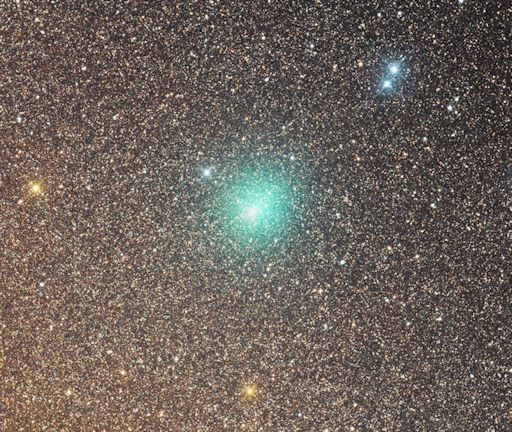
"The comet still sports a gorgeous green atmosphere ('coma') and is now exiting the dense Ophiuchus Milky Way starfield," says Williams. "The comet sure is moving fast!" WIlliams isn't the only observer to notice the missing tail. Moreover, the comet is at least 3 times dimmer than forecasters expected. "It is rather faint and diffuse," notes Dr. Brian Ottum of Dark Sky New Mexico, who photographed the green fuzzball on Feb. 7th. "45P seems unlikely to reach naked eye visibility." What happened? On Dec. 31, 2016, the comet slingshot around the sun inside the orbit of Venus. Solar heating might have vaporized so much material from the comet's icy core that there is insufficient left for a flamboyant tail. For the same reason, the comet may be dimmer than expected. Amateur astronomers with small telescopes can monitor the situation. The best time to look is during the dark hours before sunrise between Feb 9th and 12th. The comet will be racing through the constellation Hercules high in the eastern sky. Sky maps: Feb. 9, 10, 11, 12. Got a great picture? First, submit it to Spaceweather.com. Next, send it to the Planetary Science Institute, which is collecting amateur images to help professional researchers study Comet 45P. More resources: 3D Orbit, Ephemeris. Realtime Comet Photo Gallery SPACE JEWELRY FOR VALENTINE'S DAY: Did you know that cosmic radiation in Earth's atmosphere is increasing? It's true. These and other findings of the Earth to Sky Calculus ballooning program are funded not by government grants or corporate donations. Instead, the students rely on crowdfunding. Or rather, bling-funding: 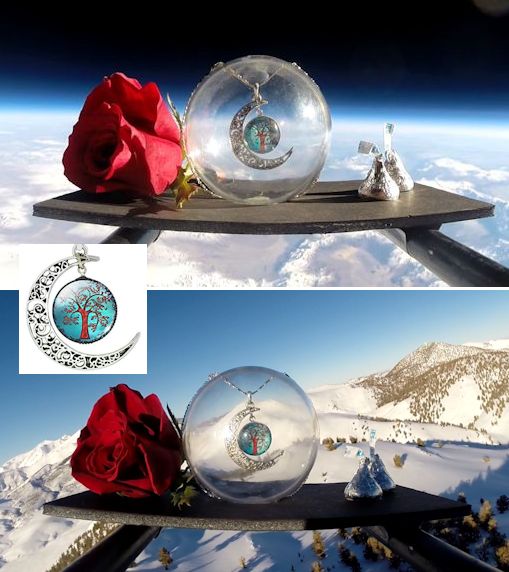
To raise funds for their ongoing research, on Jan.27th the students flew a payload-full of these Tree of Life Pendants to the edge of space. You can have one for $79.95. A space rose is included, too, pressed for safekeeping. Each pendant+rose gift package comes with a Valentine's card showing the bears in flight and telling the story of their trip to the stratosphere. Select 2nd Day Air at checkout to get it in time for Valentine's Day. More out of this world gifts may be found in the Earth to Sky store. LUNAR ECLIPSE THIS FRIDAY NIGHT: The full Moon will lose some of its usual luster on Friday night as an eerie shadow creeps across the lunar disk. It's a penumbral lunar eclipse, visible from every continent except Australia. Graphic artist Larry Koehn created this animation of the event: A penumbral eclipse happens when the Moon passes through the pale outskirts of Earth's shadow. It is much less dramatic than a total lunar eclipse. In fact, when observers are not alerted beforehand, they often do not realize an eclipse is underway. Nevertheless, the subtle shadow of Earth is visible to the naked eye. The best time to look is Friday night around 07:44 p.m. Eastern Time (00:44 UT). That's the time of maximum coverage when Earth's shadow creates a clear gradient of light and shadow across the lunar disk. Check out this global visibility map to see if you are in the eclipse zone: 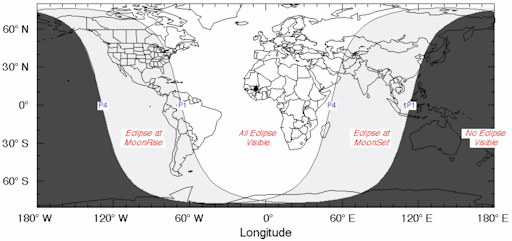
According to folklore, a full Moon in February is called the "Snow Moon." For northerners, it often feels like the brightest Moon of the year as moonlight glistens off the white landscape. For a while on Friday night, it won't seem quite so bright. Realtime Space Weather Photo Gallery
Realtime Aurora Photo Gallery
Realtime Airglow Photo Gallery
Realtime Sprite Photo Gallery Every night, a network of NASA all-sky cameras scans the skies above the United States for meteoritic fireballs. Automated software maintained by NASA's Meteoroid Environment Office calculates their orbits, velocity, penetration depth in Earth's atmosphere and many other characteristics. Daily results are presented here on Spaceweather.com. On Feb. 8, 2017, the network reported 16 fireballs.
(16 sporadics)  In this diagram of the inner solar system, all of the fireball orbits intersect at a single point--Earth. The orbits are color-coded by velocity, from slow (red) to fast (blue). [Larger image] [movies] Potentially Hazardous Asteroids ( PHAs) are space rocks larger than approximately 100m that can come closer to Earth than 0.05 AU. None of the known PHAs is on a collision course with our planet, although astronomers are finding new ones all the time. On February 8, 2017 there were 1773 potentially hazardous asteroids. Notes: LD means "Lunar Distance." 1 LD = 384,401 km, the distance between Earth and the Moon. 1 LD also equals 0.00256 AU. MAG is the visual magnitude of the asteroid on the date of closest approach. | | Cosmic Rays in the Atmosphere |
Readers, thank you for your patience while we continue to develop this new section of Spaceweather.com. We've been working to streamline our data reduction, allowing us to post results from balloon flights much more rapidly, and we have developed a new data product, shown here: 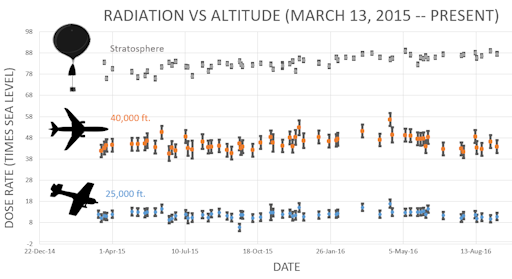
This plot displays radiation measurements not only in the stratosphere, but also at aviation altitudes. Dose rates are expessed as multiples of sea level. For instance, we see that boarding a plane that flies at 25,000 feet exposes passengers to dose rates ~10x higher than sea level. At 40,000 feet, the multiplier is closer to 50x. These measurements are made by our usual cosmic ray payload as it passes through aviation altitudes en route to the stratosphere over California. What is this all about? Approximately once a week, Spaceweather.com and the students of Earth to Sky Calculus fly space weather balloons to the stratosphere over California. These balloons are equipped with radiation sensors that detect cosmic rays, a surprisingly "down to Earth" form of space weather. Cosmic rays can seed clouds, trigger lightning, and penetrate commercial airplanes. Furthermore, there are studies ( #1, #2, #3, #4) linking cosmic rays with cardiac arrhythmias and sudden cardiac death in the general population. Our latest measurements show that cosmic rays are intensifying, with an increase of more than 12% since 2015: 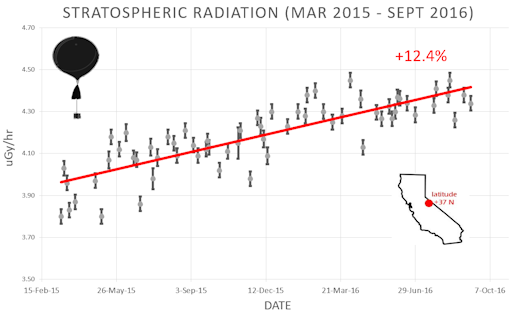
Why are cosmic rays intensifying? The main reason is the sun. Solar storm clouds such as coronal mass ejections (CMEs) sweep aside cosmic rays when they pass by Earth. During Solar Maximum, CMEs are abundant and cosmic rays are held at bay. Now, however, the solar cycle is swinging toward Solar Minimum, allowing cosmic rays to return. Another reason could be the weakening of Earth's magnetic field, which helps protect us from deep-space radiation. The radiation sensors onboard our helium balloons detect X-rays and gamma-rays in the energy range 10 keV to 20 MeV. These energies span the range of medical X-ray machines and airport security scanners. The data points in the graph above correspond to the peak of the Reneger-Pfotzer maximum, which lies about 67,000 feet above central California. When cosmic rays crash into Earth's atmosphere, they produce a spray of secondary particles that is most intense at the entrance to the stratosphere. Physicists Eric Reneger and Georg Pfotzer discovered the maximum using balloons in the 1930s and it is what we are measuring today. | | The official U.S. government space weather bureau | | | The first place to look for information about sundogs, pillars, rainbows and related phenomena. | | | Researchers call it a "Hubble for the sun." SDO is the most advanced solar observatory ever. | | | 3D views of the sun from NASA's Solar and Terrestrial Relations Observatory | | | Realtime and archival images of the Sun from SOHO. | | | from the NOAA Space Environment Center | | | a proud supporter of science education and Spaceweather.com | | | the underlying science of space weather |  | Beautyz for top beauty products reviews and their buying guides | | | These links help Spaceweather.com stay online. Thank you to our supporters! | | 
